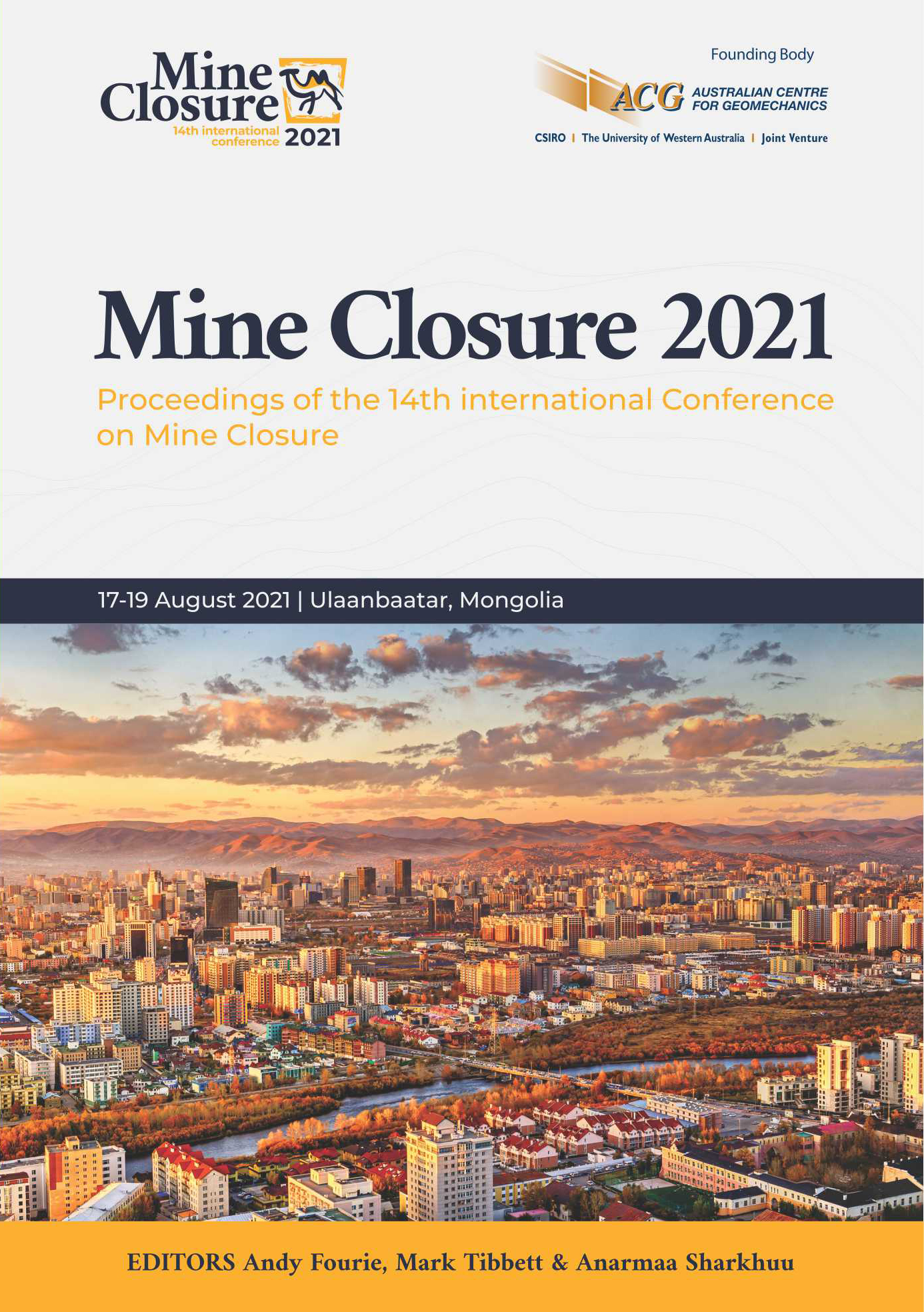Weak rock open pit slope stability considerations to inform workplan for evaluating the position of permanent mine infrastructure: a northern Canada mine case study

|
Authors: Saunders, E; LeRiche, A |
DOI https://doi.org/10.36487/ACG_repo/2152_119
Cite As:
Saunders, E & LeRiche, A 2021, 'Weak rock open pit slope stability considerations to inform workplan for evaluating the position of permanent mine infrastructure: a northern Canada mine case study', in AB Fourie, M Tibbett & A Sharkuu (eds), Mine Closure 2021: Proceedings of the 14th International Conference on Mine Closure, QMC Group, Ulaanbaatar, https://doi.org/10.36487/ACG_repo/2152_119
Abstract:
Operating open pits are exposed to geotechnical stability risks throughout the life of mine. These risks can be considered part of normal operating conditions and are managed by mining teams. Following the completion of mining, weak rock slopes can exhibit progressive failure mechanisms due to severe erosion or deterioration and are negatively influenced by the post-mining hydrogeological and hydrology conditions. In this context, these failure mechanisms can impact existing or planned mine infrastructure (e.g., water treatment, diversion channels, closure landforms) that is needed to achieve mine closure objectives. This paper describes key geotechnical and hydrogeological aspects that need consideration in developing a work plan for rigorous mine closure open pit stability assessment in weak rocks. The paper is supported by a case study of a pit stability assessment at the Faro Mine Complex, a former lead-zinc open pit located in Yukon Territory, Canada. For this case study, the importance of the stability assessment work to the positioning of a new permanent non-contact water diversion channel is described, including locating the alignment outside of the predicted long-term pit slope break-back.
References:
Cano, M & Tomas, R, & Riquelme, A 2016, ‘Preliminary relationship between weathering behaviour profiles and laboratory slake behaviour of carbonatic flysch rocks’. In Proceedings from Eurorock 2016.
De Bruyn, I, Prado, D, Mylvaganam, J & Walker, D 2019, ‘Geotechnical Considerations for the Stability of Open Pit Excavations at Mine Closure: Some Scenarios’, in AB Fourie & M Tibbett (eds), Proceedings of Mine Closure 2019, Australian Centre for Geomechanics, Perth, pp. 235 – 248.
De Graaf, PJH, Desjardins, M & Tsheko, P 2019, 'Geotechnical risk management for open pit mine closure: a sub-arctic and semi-arid case study', in AB Fourie & M Tibbett (eds), Proceedings of the 13th International Conference on Mine Closure, Australian Centre for Geomechanics, Perth, pp. 211-234
Hack, HRGK 2000, ‘Weathering, Erosion, and Susceptibility to Weathering’, in Jani, M, He, M and Riberira E Sousa, L (eds), Soft Rock Mechanics and Engineering, 1st ed, Ch. 11, Cham, Switzerland.
Huisman, M, Hack, HRGK & Nieuwenhuis, JK 2006, ‘Predicting Rock Mass Decay in Engineering Lifetimes: The Influence of Slope Aspect and Climate’, Journal of Environmental and Engineering Geoscience, vol. 12, no. 1, pp. 39-51.
Hutchinson, JN 1998, ‘A Small-Scale Field Check on the Fisher-Lehmann and Bakker-Le Heux Cliff degradation Models’. Journal of Earth Surface Processes and Landforms, vol. 23, pp.913 – 916.
Fookes, PG, Gourley, CS & Ohikere, C 1988, ‘Rock Weathering in Engineering Time’, Quarterly Journal of Engineering Geology, vol. 21, no. 1, pp. 33-57.
Martin D, & Stacey, P 2018. Guidelines to Open Pit Slope Design in Weak Rocks. CSRIO Publishing.
McCullough CD, Schultze M, Vandenberg J 2020 ‘Realising beneficial end uses from abandoned pit lakes’. Minerals vol. 10 pp. 133
Murphy, B & Barnett, W 2018, ‘Approach to Geotechnical Characterization and Slope Design Data Acquisition Programs In Different Deposit Types’, in Proceedings of the 2018 International Symposium on Slope Stability in Open Pit Mining and Civil Engineering, Asociacion Nacional de Ingenieros de Minas, Seville, pp. 1315–1329.
Peltier, L 1950. ‘The Geographic Cycle in Periglacial Regions as it is Related to Climatic Geomorphology’.
Annals of The Association of American Geographers vol. 40, no. 3, pp. 214-236
Read, J & Stacey, P 2009. Guidelines to Open Pit Slope Design. CSIRO Publishing.
Shinjo, T & Ito, T 1989, ‘Slope excavation, In Recent Advances in Soft Rock Research’, Rept. of ISSMFE Tech. Com. Soft Rocks and Ind. Soils and Proc. Disc. Ses. 5, Rio de Janeiro, Brazil, pp. 31-43.
© Copyright 2025, Australian Centre for Geomechanics (ACG), The University of Western Australia. All rights reserved.
View copyright/legal information
Please direct any queries or error reports to repository-acg@uwa.edu.au
View copyright/legal information
Please direct any queries or error reports to repository-acg@uwa.edu.au
